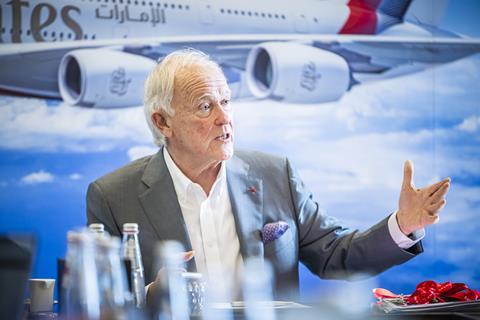Emirates Airline president Tim Clark has contrasted the investment in airports in the Middle East and Asia with activity in other regions, saying the latter are failing to keep pace.
Speaking during a roundtable briefing at the IATA AGM in Dubai on 2 June, Clark cited London Heathrow as an example of an airport that requires investment.

“The investment that needs to go into Heathrow needs to move at pace,” Clark says.
“The airport is seriously lagging behind in many of its customer-facing functions.”
The problem is not the management of Heathrow, which has been supportive of Emirates, he says, but comes from a lack of investment by the owners – something that he suggests might change now that the facility has new major shareholders.
And the issues are by no means unique to the London hub, Clark says.
Aside from Heathrow, Amsterdam Schiphol is “going south” amid moves by the government to cap traffic at the airport, he says, adding: “I don’t see much going on in France. I don’t see much going on in the US.”
Airport owners everywhere should always be looking beyond immediate shareholder value, Clark says, and on to long-term investments in the airport experience – successful implementation of which will encourage return visits.
Rather, therefore, than asking “how much money can I make from this?”, airport owners should “look at what’s happening in that terminal”.
The current airport shortcomings are concerning in a global airline sector that expects to growth significantly in the coming decades, Clark states.
“If you believe that demand will increase… you’ve got to invest, you’ve got to do things,” he says.
“They can do so much better… And they can do that with existing resources. They can do that with technology. And they can monetise and create wealth from that, which will pay for the investments.”
Dubai is taking action, he notes, amid plans for Emirates to shift operations to Al Maktoum International airport in the 2030s.
“If you can provide a place where people are happy, content… it’s really going to be fun to go through, really interesting and easy to make the connections that it’s going to provide,” Clark says.
And there are other examples of similar activity in the Middle East and Asia, he adds.
“All around, certainly in our part of the world and in Asia, new airports are being built employing the latest technologies to streamline the process of all the customer-facing functions… and making the whole thing a lot easier.
“You’ve seen what Changi does, you’ve seen what Qatar has done with its extension,” Clark says. “They’ve got it. Why can’t the Europeans get it?”


























